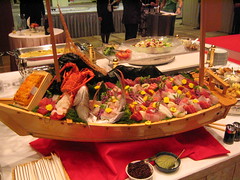

The Sushi Bicycle - Selling Sushi at Copenhagen Beaches
In a recent post - ' If You Want Cycle Transport, Make Cycle Transport Sexy ' by Brian Glover - I delved briefly into a comparison between the journey of sushi from obscurity in the western world to being a mainstream culinary dish.
I still can't find the link to a study I read about a few years back that used the proliferation of sushi restaurants as a yardstick in research to determine how age affects peoples desire to try new things in life. Eating new foods, voting for different political parties, listening to new music.
But it got me thinking about sushi and comparing it to 'bicycle culture'. It's particularly relevant as I so often hear - either whilst speaking in other countries or here on this blog things like " you don't understand... we live in a different culture. "
I don't buy that at all, which is why I focus on marketing, anthopology and the fact that the behaviour of homo sapiens - and changing that behaviour - is quite universal. Now, there are differences in marketing in different countries. Canon has a camera that is sold around the world. In Japan, they sell it as the Ixy [cutesy name], they sell it as Ixus in Europe [grand, like a Greek god] and the same camera is called Powershot on the American market.
Carmakers have always battled with finding names that cross borders. A name which sounds great in a dozen languages may flop in one other. Volkswagon discovered that their Sharan model didn't fly in the UK because the girl's name Sharon has negative associations with a 'certain kind of girl'.
The Mitsubishi Pajero is sold as the Shogun in the UK and as the Montero in Spanish-speaking countries and North America because pajero means wanker in Castilian Spanish. The Buick LaCrosse was sold as the Buick Allure in Canada, as la crosse means masturbation or swindling in Québécois slang. It's all called badge engineering.
The products are, however, all the same. They're still just selling cameras and cars to consumers. Cellphones, mobiles or handys all do the same thing.
How did something as bizarre [to the western palate] as sushi conquer the world? Raw fish on sticky rice served with a green, horseradishy paste and dipped in soya sauce? Now available at in Canadian prairie supermarkets and in Moscow cafés.
Surely, if something as bizarre as sushi can become mainstream by leaping across well-protected and fiercely defended culinary and cultural borders then there must be good odds for the bicycle's return to the urban landscape.
The bicycle is universal. I know many people who have never even tried sushi, but I don't know anyone who can't ride a bicycle. Even if they never ride one, they've learned it and enjoyed it.
A couple of generations ago, our families were eating the same, largely unchanged, cuisine as their ancestors. The bicycle, however, was not unfamiliar to them.
So what was sushi's journey to success and globalisation? Can we use the example in marketing mainstream bicycle culture?
Theodore C. Bestor wrote an article in Foreign Policy ten years ago called How Sushi Went Global.
Little mention of any Japanese food appeared in U.S. media until well after World War II. By the 1960s, articles on sushi began to show up in lifestyle magazines like Holiday and Sunset. But the recipes they suggested were canapŽs like cooked shrimp on caraway rye bread, rather than raw fish on rice.
A decade later, however, sushi was growing in popularity throughout North America, turning into a sign of class and educational standing. In 1972, the New York Times covered the opening of a sushi bar in the elite sanctum of New York's Harvard Club. Esquire explained the fare in an article titled "Wake up Little Sushi!" Restaurant reviewers guided readers to Manhattan's sushi scene, including innovators like Shalom Sushi, a kosher sushi bar in SoHo.
Japan's emergence on the global economic scene in the 1970s as the business destination du jour, coupled with a rejection of hearty, red-meat American fare in favor of healthy cuisine like rice, fish, and vegetables, and the appeal of the high-concept aesthetics of Japanese design all prepared the world for a sushi fad. And so, from an exotic, almost unpalatable ethnic specialty, then to haute cuisine of the most rarefied sort, sushi has become not just cool, but popular.
The painted window of a Cambridge, Massachusetts, coffee shop advertises "espresso, cappuccino, carrot juice, lasagna, and sushi." Mashed potatoes with wasabi (horseradish), sushi-ginger relish, and seared sashimi-grade tuna steaks show Japan's growing cultural influence on upscale nouvelle cuisine throughout North America, Europe, and Latin America. Sushi has even become the stuff of fashion, from "sushi" lip gloss, colored the deep red of raw tuna, to "wasabi" nail polish, a soft avocado green.

In Walter F. Carroll's paper SUSHI: Globalization through Food Culture: Towards a Study of Global Food Networks - (opens as .pdf) he writes about Sasha Issenbergs's book The Sushi Economy: Globalization and the Making of a Modern Delicacy , saying that:
"He suggests that there is much to admire in the worldwide sushi trade and argues that it shows that “'virtuous global commerce and food culture can exist'.
What makes that trade potentially virtuous for him is “on a new landscape of consumption, power is decentralized, and supply and demand are regulated not by moguls but by local ideas about value and taste”.
Carroll continues:
"From beginnings in the Little Tokyo section of the city in the 1950s, eventually “sushi had found its second home”. Although some types of sushi were available in Little Tokyo, sushi’s wave of popularity in Los Angeles came with the movement of Japanese managers and executives to the United States when the Japanese economy was thriving during the 1960s. Their expense accounts enabled them to enjoy the relatively expensive sushi in Los Angeles. It was at this point that nigiri and fish maki began to be available. This led to the launching of new sushi restaurants and the increasing visibility of the dish. Issenberg (2007), from whom I draw this account, also notes some of the barriers to the acceptance of sushi in the United States, noting that “while foreign flavors have long seeped into American foodways, sushi had unique challenges.
Unlike other “ethnic foods,” in America, sushi was not an inexpensive, neighborhood-based food. “In large part because of its celebrated aesthetics, Japanese food was always seen as fussy haute cuisine” and this slowed its acceptance."
Perhaps I got carried away there, but I found it interesting. Sushi conquered the world. Surely the bicycle's journey back to our cities and towns should be a piece of cake.
Sushi was 'trendy' in L.A. and then New York, where it stranded for a while - but didn't go away. The Theory of Diffusion of Innovations came into play. The Innovators took hold of sushi. It moved over to the Early Adopters and then the Early Majority. It's now been embraced by the Late Majority and, in the case of sushi, there are probably many Laggards who will never try it. Nevertheless, it's a success.
The bicycle is 'hot' again, all over the world. With a bit of luck, the trend won't fade and we will continue to sell urban cycling positively, in order to allow the bicycle to tango its way into the lives of the Early Majority. We're well on our way.
I can't wrap this up [in newspaper] without a fish metaphor. Johannes V. Jensen was a famous Danish writer. In his novel Gudrun, from 1935, he compares the cycling Copenhageners to schools of fish:
"If one is bumped by a car, the whole school is bumped. It's a nerve one has in the elbow, a flock function, which Copenhageners have learned so well that it is second nature".

Disclaimer: This post is about comparing sushi and bicycle relating to marketing and trends. It has nothing to do with overfishing, declining fish stocks, etc. I'll recommend my friend Taras' book Bottomfeeder: How to Eat Ethically in a World of Vanishing Seafood (Taras Grescoe 2008) on THAT subject.
And I'm probably never going to have the chance to blog this video of mine on a bicycle blog again, so here goes:




